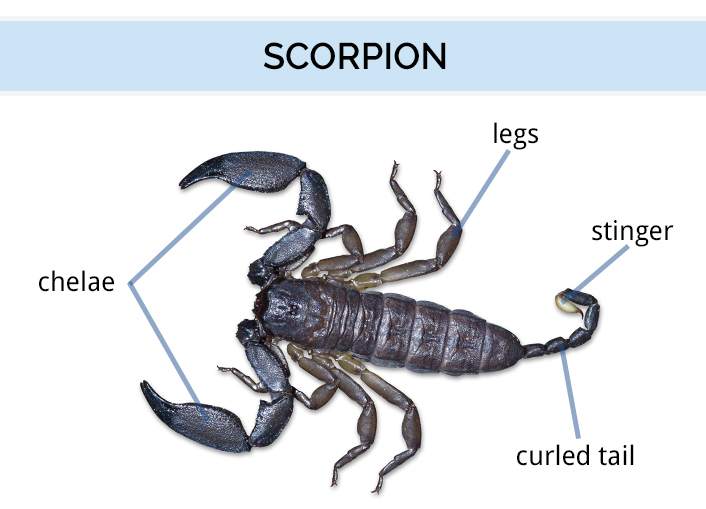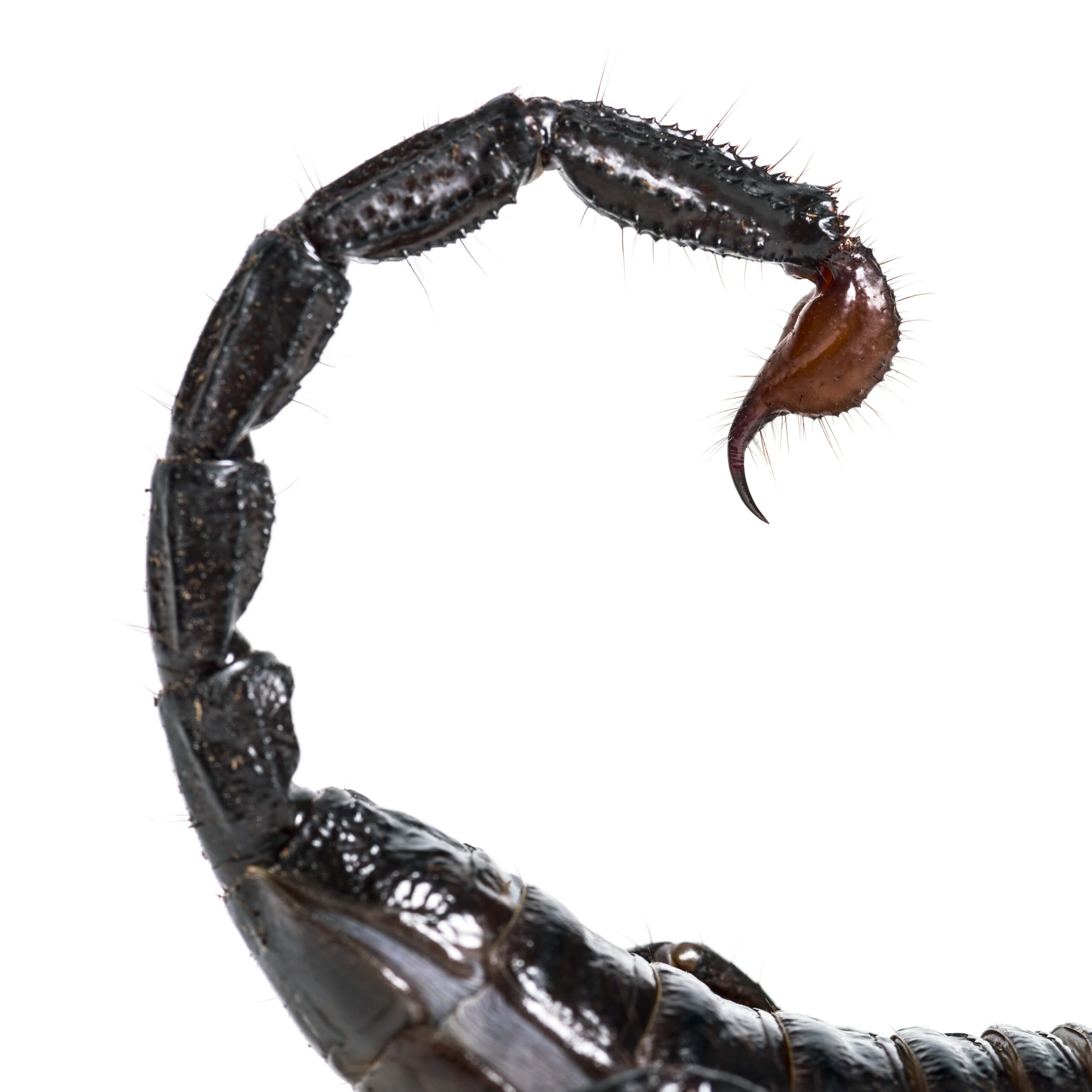Scorpion Sting and Venom
A World of Arachnids
Picture this: arid landscapes, scorching deserts, and a creature that evokes both fear and fascination – the scorpion. With their menacing pincers, segmented bodies, and venomous tails, scorpions have long captivated our imaginations. As members of the arachnid family, they are closely related to spiders, ticks, and mites.
These intriguing creatures have roamed the Earth for millions of years, adapting to survive in diverse habitats across the globe. From hidden crevices to sandy burrows, scorpions can be found lurking in various corners of our planet.
Explore Our Expert Scorpion Control Services! Discover how our professional scorpion control and treatment services can effectively tackle your scorpion infestation. Click to learn more about our professional scorpion control and treatment services!
The Lethal Elixir: Scorpion Venom

Now let’s turn our attention to the sinister side of these remarkable beings: their venom. Within their stingers lies a potent cocktail capable of inducing pain and wreaking havoc on living organisms. Composed of a complex mixture of peptides and proteins specific to each species, scorpion venom serves multiple purposes including capturing prey and defending against potential hazards.
This extraordinary concoction contains a myriad of toxins designed to incapacitate or even kill their victims. Scorpion venom is far from a one-size-fits-all concoction; it exhibits an astonishing diversity across different species.
Some venoms primarily target the nervous system causing paralysis or muscle spasms while others attack organs such as the heart or lungs. The composition varies not only between species but also within individuals belonging to other species within the same species based on factors such as geography and diet.
As incredible as it sounds, some researchers believe that studying scorpion venom’s components might uncover valuable insights into treating certain diseases in humans. However, before delving into this tantalizing prospect later in our journey through these enigmatic creatures’ world, let us first explore their anatomy and the mechanics behind their formidable sting.
Scorpion Anatomy and Stinging Mechanism

Unveiling the Scorpion’s Formidable Arsenal
When it comes to understanding scorpion stings, it is crucial to delve into their peculiar anatomy. These fascinating arachnids boast a unique body structure that sets them apart from other creatures in the animal kingdom. Their distinct features include menacing pincers, or chelicerae, at the front of their bodies, followed by a slender yet robust tail that culminates in their notorious weapon: the scorpion’s stinger.
The Mighty Sting: A Lethal Weapon in Action
The scorpion’s stinger is undoubtedly its most notorious attribute, instilling fear and trepidation in those who encounter these arthropods. Positioned menacingly at the end of their tail, the stinger is a highly specialized tool designed for injecting venom into prey or potential threats.
The scorpion’s stinger is a complex structure composed of a sharp needle-like shaft connected to venom glands located within its abdomen. When threatened or attacking prey, scorpions arch their tails over their backs and strike with lightning speed using their powerful abdominal muscles.
The venomous sting punctures through the target’s skin, delivering a potent cocktail of toxins directly into the bloodstream. This venom serves two primary purposes: immobilizing prey and defending against predators.
Appearance and Effects of a Scorpion Sting
If you’ve ever wondered what a scorpion sting looks like, our comprehensive guide on what does a scorpion sting look like provides valuable insights. Learn how to identify the visual characteristics of a scorpion sting, including redness, swelling, and localized pain. Educate yourself about scorpion stings to ensure prompt and appropriate treatment when needed. Don’t wait – click here to discover what a scorpion sting looks like!
Risk Factors and Severity of Scorpion Stings
When it comes to scorpion stings, understanding the risks involved is crucial. Our article on can you die from a scorpion sting explores the factors that contribute to the severity of scorpion envenomation. Discover the species-specific risks, potential complications, and when to seek immediate medical attention. Your knowledge could make a life-saving difference.
Duration of Symptoms and Healing Process
If you’ve been stung by a scorpion, you may be wondering how long the discomfort will persist. Our article on how long does a scorpion sting last provides insights into the duration of symptoms and the healing process. Get a better understanding of the timeline for pain, swelling, and other symptoms associated with scorpion stings.
First Aid Measures and Home Remedies
Knowing how to treat a scorpion sting promptly can make a significant difference in your recovery. Our comprehensive guide on how to treat a scorpion sting offers valuable tips and strategies. Learn about first aid measures, home remedies, and over-the-counter options to alleviate symptoms and promote healing.
Composition and Medical Research
Explore the fascinating world of scorpion venom with our article on scorpion venom. Delve into the composition, effects, and potential medical applications of scorpion venom. Learn about the diverse compounds found in scorpion venom and ongoing medical research related to this intriguing substance. Uncover the secrets of scorpion venom and its potential impact on medical science.
Venomous Potential of Baby Scorpions
When it comes to baby scorpions, many people wonder if they are poisonous. Our article on are baby scorpions poisonous provides insights into the venomous potential of these young arachnids. Discover the facts about baby scorpions and their ability to inject venom. Understand the risks associated with encountering baby scorpions to ensure your safety.
Understanding the Toxicity of Bark Scorpions
Bark scorpions are known for their venomous nature, but many people wonder just how poisonous they are. Our article on are bark scorpions poisonous explores the toxicity of these scorpions. Gain insights into the potency of their venom, the symptoms of their stings, and the importance of taking precautions.
A Dual-Purpose Tool: Utility Beyond Venom Delivery
While delivering potent venom is undoubtedly the primary function of a scorpion’s stinger, it also serves additional purposes that contribute to its survival in harsh environments. For instance, some species of scorpions use their tail as an efficient sensory organ to navigate their surroundings and detect potential threats or prey items.
Moreover, certain species possess specialized structures on their pincers known as “combs,” which they use to groom themselves and spread venom across their bodies. This venom acts as a protective shield, deterring predators from attacking and preventing the growth of harmful microorganisms.
Understanding the intricacies of scorpion anatomy, including their pincers and stingers, allows us to appreciate the evolutionary adaptations that have allowed these creatures to thrive for millions of years. However, it is essential to remember that despite their intriguing biology, interactions with scorpions should be approached with caution to avoid the potential consequences of severe scorpion stings.
Types of Scorpions with Potent Venom
Deadly Stingers: Meet the Lethal Scorpion Gang

When it comes to potent venom, there are a few notorious scorpion species that have gained quite a reputation. One of them is the Deathstalker, a fearsome name for a fearsome creature.
This small but deadly arachnid is found in regions like North Africa and the Middle East. Its sting packs a powerful punch, causing intense pain and systemic effects that can even be life-threatening.
Another venomous superstar is the Arizona bark scorpion, commonly found in southwestern parts of the United States. Though its sting may not be as lethal as the Deathstalker’s bite, it can still trigger severe symptoms in humans.
The Power of Poison: Diverse Potency Levels
Not all scorpions are created equal when it comes to their venom potency levels. While most scorpion stings cause only localized pain and discomfort, others can elicit more severe reactions.
The level of toxicity in scorpion venom varies depending on factors such as species, geographical location, and individual variations within populations. For instance, the aforementioned Deathstalker has one of the most potent venoms amongst scorpions and can cause symptoms ranging from excruciating pain to difficulty breathing and high blood pressure.
Interestingly enough, venom potency does not always correlate with size or appearance—some small scorpions possess incredibly potent venoms while larger ones may have relatively milder toxins. For example, the Brazilian yellow scorpion may appear harmless due to its diminutive size but packs a punch that produces intense pain and muscular contractions.
Scary But Fascinating World: Exploring Venom Diversity
Scorpions live in various habitats around the world, each harboring unique species with distinct venoms. The incredible diversity in scorpion venoms is a fascinating realm for scientific exploration. Some venoms primarily target the nervous system, causing symptoms like muscle spasms, blurred vision, and difficulty swallowing.
Others may have more hemotoxic properties, affecting blood cells and clotting mechanisms. Researchers are captivated by the potential medical applications hidden within these venomous cocktails.
Some components of scorpion venom have shown promise in cancer research, demonstrating the ability to selectively target tumor cells. By unraveling the mysteries of these venoms, scientists hope to unlock new avenues for treating diseases and improving human health.
With such a vast array of scorpion species and their venomous capabilities spread across the globe, it’s truly awe-inspiring how nature has crafted such deadly yet enigmatic creatures. As we delve deeper into the world of scorpions and their potent venoms, we gain not only a greater understanding of their biological significance but also potential insights into our own well-being and medical treatment advancements.
Effects of Scorpion Venom on Humans

A Painful Encounter: Symptoms experienced after a scorpion sting
Being stung by insects or a scorpion can be an excruciating experience. The pain is often immediate and intense, radiating from the affected area. Victims often describe it as a burning or throbbing sensation.
Alongside the pain, swelling and redness may occur at the site of the sting. These local symptoms can vary in intensity depending on factors such as the species of scorpion, the amount of venom injected, and an individual’s sensitivity to the venom.
However, it’s important to note that not all scorpion stings lead to severe reactions. In most cases, symptoms remain localized and gradually subside over time with appropriate care.
Applying a cool compress, compresses or an ice pack wrapped in cloth can help alleviate pain and reduce swelling at the site of the sting. It is recommended to avoid using direct ice applications to prevent damage to the skin.
Beyond Skin Deep: Systemic effects on different body systems
While local symptoms are distressing enough, scorpion venom can have systemic effects that may affect various body systems. The cardiovascular system may be impacted by rapid pulse rate, increased blood pressure, irregular heart rhythm, or even myocardial infarction in severe cases. Respiratory disturbances are another concern when dealing with scorpion envenomation.
Some individuals may experience shortness of breath or difficulty breathing due to airway constriction caused by allergic reactions or direct action of the venom on lung tissue. Additionally, neurological manifestations are not uncommon after being stung by a venomous scorpion species.
These may include muscle spasms and tremors due to the overstimulation of nerve cells by neurotoxins present in some venoms. Other signs like roving eye movements or uncontrolled limb movements might also occur in severe cases.
Given the potential for systemic effects, it is crucial to seek immediate medical attention when stung by a scorpion, especially if the person stung is a child or an elderly individual. Even when symptoms appear mild initially, it is advisable to contact the nearest urgent care facility, emergency department or poison control center for guidance as they can provide appropriate advice based on the specific situation.
Remember, every scorpion sting is unique, and reactions can vary widely. It’s always better to err on the side of caution and seek medical care promptly rather than risk potential complications from scorpion venom.
Medical Importance and Treatment Options
The Scorpion Sting Conundrum: A Public Health Concern
Scorpion stings, while generally not life-threatening for healthy individuals, are considered a significant public health concern in certain regions. This is especially true in areas where venomous scorpions are prevalent, such as parts of North Africa, the Middle East, South America, and the southwestern United States. The primary reason for this concern is that vulnerable populations, including children and older adults, are at a higher risk of developing severe symptoms after a sting.
Furthermore, some species of scorpions tend to inhabit residential areas where factors like overgrown vegetation or cluttered outdoor spaces can provide ideal hiding spots bark scorpions. In these regions, the potential for human-scorpion encounters increases substantially.
Treatments: Battling Venom with Antivenom

When it comes to treating scorpion stings effectively, healthcare professionals have developed various strategies to combat the effects of venom. The most critical aspect of the treatment for scorpion stings lies in managing symptoms promptly and providing supportive care measures.
For severe cases or when systemic symptoms manifest rapidly after a sting from highly venomous species like the tree bark scorpion sting (found primarily in North America), administration of specific antivenom is crucial. Antivenom works by neutralizing the toxic components present in scorpion venom and preventing further damage to bodily functions.
It can swiftly alleviate serious symptoms such as difficulty breathing or excessive sweating associated with envenomation. However, given its limited availability and potential side effects like severe allergic reaction, reactions, or serum sickness (a delayed immune response), antivenom is typically reserved for individuals experiencing substantial toxicity.
In cases where severe symptoms are not present but discomfort persists after an encounter with less dangerous scorpions or if medical assistance is not readily accessible, self-care measures can be employed. These include cleaning the affected area with mild soap and water, applying an ice pack to sting site to reduce pain and swelling, and taking over-the-counter pain relievers if recommended by a healthcare professional.
The Role of Education and Prevention
Considering that prevention is better than cure, educating individuals living in scorpion-prone regions about scorpion behavior and habitats can play a pivotal role in reducing the frequency of stings. Implementing measures like keeping grass closely mowed, clearing clutter from outdoor areas, sealing cracks in walls or floors, and removing debris that may serve as potential hiding spots can minimize the risk of scorpion encounters. Additionally, taking precautions such as shaking out shoes before wearing them or using gloves while working in gardens can further prevent accidental stings.
While most scorpion stings do not warrant immediate medical attention or cause serious symptoms, they remain a public health concern due to their potential impact on disease control in vulnerable populations and the prevalence of venomous species in specific regions. Swift administration of scorpion antivenom alongside supportive care measures is crucial for managing severe envenomation cases effectively.
However, promoting education about scorpions’ habits and habitats along with preventive measures is equally important to mitigate the risk of encounters that could lead to painful stings. Remember: stay informed, stay prepared!
Uncovering the Mysteries: Research on Scorpion Venoms

Exploring Medical Applications and Beyond
Scorpion venoms, with their intricate composition, have become a subject of intense scientific research in recent years. One striking area of exploration involves investigating the potential medical applications of scorpion venom components, particularly in the field of cancer research.
Preliminary studies suggest that certain compounds found in scorpion venom may possess anti-cancer properties, showing promise as a potential source for developing novel therapeutic agents. This avenue of inquiry holds immense potential for future advancements in cancer treatment and underscores the importance of understanding these enigmatic arachnids.
Further analyzing scorpion venoms not only offers hope for medical breakthroughs but also contributes to our understanding of evolution and biodiversity. By studying various species of scorpions and their unique venom compositions, scientists gain valuable insights into the evolutionary adaptations that have shaped these creatures over millions of years.
The remarkable diversity observed within scorpion venoms highlights the intricacies of nature’s design and provides a deeper appreciation for the complexity inherent in these seemingly simple organisms.
Fascinating Facts about Scorpions and Their Venoms
Unveiling Nature’s Hidden Wonders
Did you know that some species of scorpions glow under ultraviolet (UV) light? This phenomenon called fluorescence has intrigued scientists for years. Although not all scorpions exhibit this remarkable trait, those that do emit an ethereal glow under UV light due to certain fluorescent molecules present in their exoskeletons.
While researchers are still unraveling the exact purpose behind this fascinating adaptation, it serves as a reminder that there is so much we have yet to discover about these mysterious creatures. Beyond fluorescence, exploring the diversity and complexity of scorpion venoms reveals an astonishing array of biochemical ingenuity.
Each species of scorpion has its unique combination of venom components, tailored to its specific ecological niche and predatory needs. Some venoms target the nervous system, causing paralysis in their prey, while others affect the cardiovascular system or disrupt cell membranes.
This incredible sophistication exemplifies how nature has honed scorpions’ venoms through millions of years of evolution, resulting in a true marvel of biochemical weaponry.
Conclusion
After delving into the captivating world of scorpion sting and venom, we are left with a sense of awe at both the scientific potential and natural wonders they hold. Ongoing research into scorpion venoms not only offers hope for breakthroughs in medical treatments but also deepens our understanding of evolution and biodiversity.
While most scorpion stings may cause severe discomfort or even serious allergic reactions, it is inspiring to know that our efforts to unravel the mysteries surrounding these remarkable creatures can lead to positive outcomes for human health. So let us embrace the allure of these enigmatic arachnids and continue our exploration into their intriguing world, fostering a future where knowledge triumphs over uncertainty.
Frequently Asked Questions:
Scorpion venom can cause various effects on the body, including pain, swelling, numbness, and in severe cases, systemic symptoms or organ failure.
Yes, scorpion stings do contain venom.
The type of venom in a scorpion sting can vary depending on the species, but it often consists of a combination of neurotoxins and enzymes.
When stung by a venomous scorpion, you may experience localized pain, redness, swelling, and other symptoms associated with envenomation.
If this article struck a chord with you, you might also find these interconnected writings intriguing:
Unveiling the Secrets of Scorpion Habitats: Where Do They Live?
Keeping Scorpions at Bay: Effective Prevention and Control Strategies








